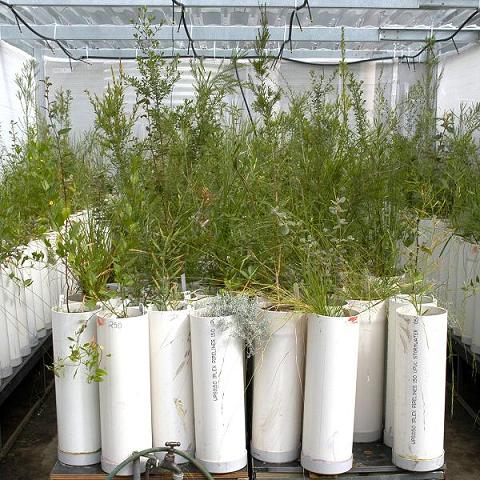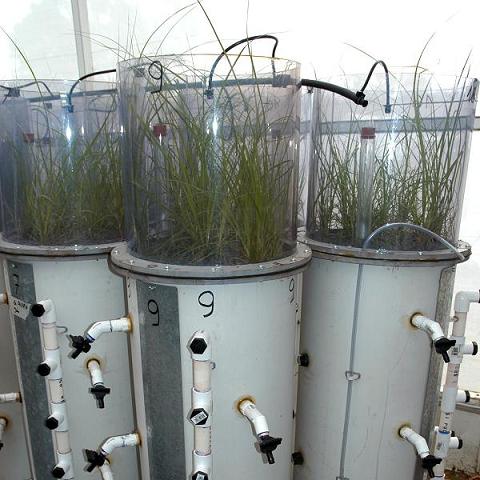|
|
|
Project 1: Technology
Key messages
Laboratory Experiments
Laboratory studies of bioretention systems were undertaken to determine the optimum design configuration (vegetation, media, outlet specifications) and operating conditions for achieving long-term, sustainable pollutant removal.
The laboratory experiments involved 800 experimental-scale bioretention columns, which were subjected to a range of test conditions.
Choosing the best plant species…
Which species can best accommodate the wetting and drying pattern in a bioretention system? Which species will support the best long-term removal of pollutants?
We tested 20 different species (including grasses, sedges, reeds, shrubs and trees) to find out, by dosing vegetated bioretention “columns” with stormwater, and measuring the growth rate and pollutant uptake of each species.
We also measured the pollutant concentration in the filter media, and the stormwater effluent.
Testing plants species suitable for bioretention systems
Influence of design and operating
- Test set up
- 150 large (375mm diameter) bioretention columns were constructed, to test the:
- Optimal filter media type (e.g. sandy loam, sandy loam with vermiculite/perlite, low pH sandy loam, activated carbon, etc)
- Optimal filter depth (up to 700mm, plus ‘transition layer’)
- Benefit and configuration of an anaerobic zone for promoting denitrification, for sustainable nitrogen removal
- Influence of plants (using 5 species chosen from the subset of 20 (above) on bioretention effectiveness in pollution reduction
- Influence on bioretention operation and effectiveness of climate, pollutant concentration and storm size
- Water quality monitoring
Each column was dosed with stormwater, and the outflow rate and pollutant (sediment, nitrogen, phosphorus, heavy metals, hydrocarbons, etc) concentration monitored.
- Health aspects
Each column was tested for its ability to produce water suitable for stormwater reuse. Testing was undertaken for pathogens, viruses and other contaminants.
Advanced bioretention columns for testing the performance anaerobic zones.
Long-term sustainability
Bioretention systems need to perform effectively over long periods.
We conducted experiments to
- Test designs and specifications of filter media and vegetation that maintain the permeability of the soil filter media
- Measure the long-term efficacy of different filter media types (ie. their pollutant adsorption capacity)
- All biofilter configurations tested (both vegetated and unvegetated) remove more than 90% of heavy metals (both particulate and dissolved). Some plant species enhance metal uptake (and may enhance filter lifespan), but plant selection will depend more strongly on hydraulic conductivity and nutrient removal (see below)
- Most biofilters will perform well for phosphorus removal, as long as the soil has a phosphorus index of less than 100 mg/kg. Whilst plants play a role in P removal, most species will perform well. Genera such as Carex, Juncus, Poa, Banksia, correa, Dodonea, Goodenia, Melalecua and Pomaderris all perform well for P removal.
- Critically, however, without vegetation, most soils will naturally leach some nitrogen. Biofilters therefore rely strongly on vegetation and its symbioses with bacteria and fungi, for the removal of nitrogen from stormwater.
- The best plants for nitrogen removal are those with (i) a dense root system which penetrates the entire soil filter meda depth, (ii) high growth rate. The following species have been found to be effective: Carex appressa, Ficinia nodosa, Juncus flavidus, Lomandra longifolia, Melaleuca ericifolia and Goodenia ovata. Where N removal is important, biofilters should be planted with at least 50% of plants from this selection, where possible, and other plants selected primarily on the morphological traits as described. Aesthetic and biodiversity considerations may also need to be taken into account.
- For maintenance of hydraulic conductivity, plants with thick roots which penetrate the entire soil profile and create macropores, are desirable. This is primarily tree species, such as Melaleuca. A combination of plants (e.g. Carex, Juncus and Melaleuca) delivers the ideal combination of traits for both hydraulic conductivity and nitrogen removal.
- The addition of vermiculite and perlite (around 5% each by volume) to the soil media may help to maintain hydraulic conductivity, making the biofilter more robust to slight deviations from the specified soil media characteristics. It is also known to enhance the (already high) heavy metal adsorption capacity of biofilters, and to help in moisture retention.
- Biofilter soil media placed 'uncompacted' will show an initially very high hydraulic conductivity, which will settle back to the design value within a few months. It is recommended that sizing/design of biofilters be undertaken using a safety coefficient of 2 in the hydraulic conductivity. e.g. if the design Ks to be used is 180 mm/hr, size the system assuming a value of 90 mm/hr.
- Some degree of leaching of fine sediment and nutrients from the soil media will usually occur during the establishment phase, until the soil has stabilised, and plant roots have occupied the soil volume (this will typically take 2-6 months).
- The presence of an anaerobic zone (made of sand or gravel with around 5% carbon source, such as woodchips) will improve nitrogen removal, by promoting denitrification. It will also enhance plant survival during drought periods, and reduce the risk of an “initial flush” of elevated nitrogen concentrations from the filter media after a prolonged dry period.
Project 1 | Project 2 | Project 3 | Project 4
|

